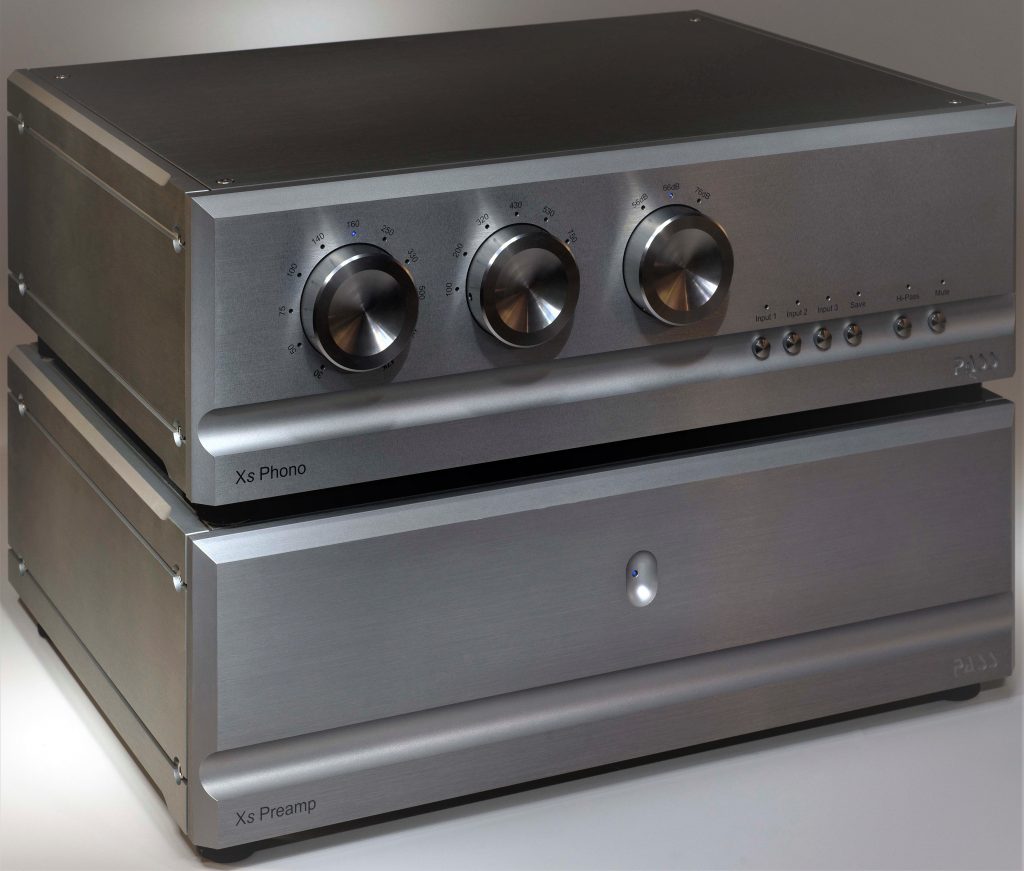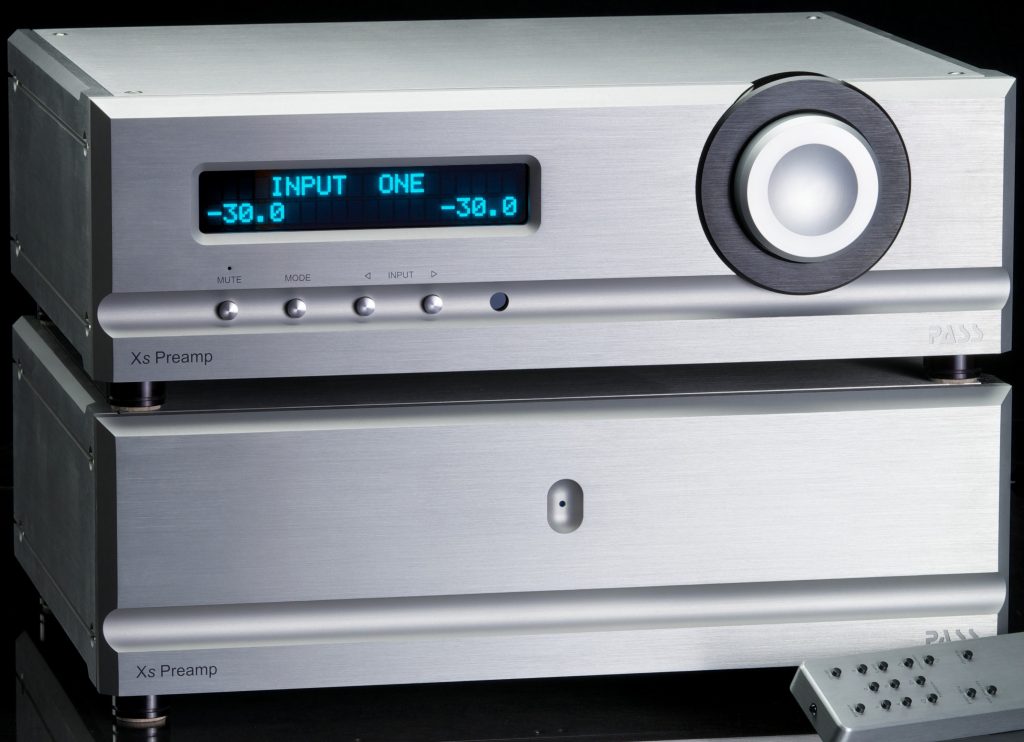The Pass Laboratory Xs Phono arrived after I have wrapped up my review of the Hartvig TT turntable system with the Ikeda IT-345CR1 tonearm and the 9TT moving-coil cartridge. The phono stage at that time was the Pass Labs XP-25, a $10,600, two-chassis phono stage that raised the splendor of vinyl playback to such heights that first informed me of the encouraging progress in state-of-the-art vinyl playback in this mature age of digital. It was the XP-25 that spurred me on to taking a more serious look at vinyl playback. The subject of this review is the Xs Phono, the only higher model in the company’s products to the XP-25.
The Pass Labs Xs Phono comes in two large chassis, and together with the identical twin-chassis of the accompanying Xs Preamplifier, signify a major presence in my system. But as designer Wayne Colburn explains in his Technical Background article, the XS is the result of an intensive exercise in product design, employing rocket science-grade gold plated circuit boards for long-term operational stability and hyper sensitivity for the feeble signals to pass through. Not only is the XS main chassis endowed with 13 of these massive, space age circuit board with 1,500 parts, and doubled up in dual-mono pairs, a whole contingent of toroidal transformers and stages of regulations fills up the separate power supply chassis. Pass Labs products are not known for being space saving, although its powerful INT-250 integrated is a different story, and for another time.
The two chassis of the Xs Phono are interconnected via a pair of umbilical cords for the dual-mono operation, and this accords the user considerable freedom in separate placements. I have noticed better tonal definition and spatiality when separating the two chassis than stacking the main chassis on top of the power supply. Still, for space-saving measures, I stacked the main chassis of the accompanying $38,000 Xs Preamplifier on top of that of the Xs Phono. Since both are main chassis that house each system’s control circuits but not the processing plant of power supplies, they pose no performance impediment issue to one another. The power supplies chassis for the phono stage and the line stage preamplifier are in different spots of the room, and no operating electronics are put atop either.
Reviewed with the Xs Phono is Allen Perkin’s $18,000 Spiral Groove Revolution turntable system with the $6,000 Centroid tonearm. Together with the Xs Preamplifier, the Pass Labs Xs Phono drove a pair of the company’s $45,000, pure class A, XA-200.8 monoblock amplifiers. A pair of $30,000 Technical Audio Device Evolution One floorstanders and $21,650 Sound Lab Ultimate 545 electrostatic panel speakers alternated with the Pass Labs monoblocks. A pair of $30,000 Bricasti Design M28 monoblock amplifiers also saw heavy duties.
A complete suite of MIT Cables Oracle series of cable system was in place, including the MA-X2 RCA interconnect for phono, MA-X SHD XLR for linking Xs Phono to Xs Preamplifier, and Xs Preamp to the XA-200.8 monoblocks, or the Bricasti Design M28. The MIT Cables Oracle Matrix Super HD 120 speaker interface drove the speakers. In the case of the TAD Evolution One, the jumper cables were the Audio Reference Technology jumper cables. Cartridges used were the Fuuga, Audio Note Io I Red and Soundsmith Paua II.
The Xs Phono provided three easy-access, large round knobs on the front for IMPEDANCE, CAPACITANCE and GAIN. Of all phono preamps I’ve used, the Xs Phono had proven to be the easiest to operate. Adjustments on moving-coil cartridges rest in the IMPEDANCE settings primarily, with a range from 30 to 47k Ohms. Capacitance adjustments were available from 100 to 750 pF, although changes had no effect on moving-coil cartridges. Since I didn’t have moving-magnets among my cartridges, I can’t report on the sound of the phono stage via changes in capacitance setting.
The GAIN circuit provided for 56, 66 and 76 dB of output and I have found the highest, 76dB setting to be perfect for all three cartridges. The Xs Phono had three pairs of RCA inputs in the back and one pair of RCA and XLR outputs. Six small, push buttons lined up towards the right of the front chassis that controls INPUT 1, 2, 3, and then SAVE, HIGH PASS FILTER and MUTE. The HIGH PASS FILTER cut off signals below 20 Hz. Many a time the features of high and low pass filters are present on budget phono stages for use in budget turntable systems, and I thought it bizarre to assume Pass Labs patrons spending $45,000 on the Xs Phono and expensive cartridges would be using the system to play warped records, probably poorly kept with massive levels of subsonic, thus needing the filtering. Kudos to the wisdom of Pass Labs, for before long I started to dig out archaic favorite albums of mine, although none of them required the filtering. The Xs Phono can memorize individual settings on each of the inputs, which is useful for reviewing purposes.
Blue LEDs are built into each change segment of the three large knobs as well as above the push-buttons, though the minimal brightness suggests close proximity operation is expected. The Audiodesksysteme Glass Vacuum Vinyl Cleaner assured me of the quality of my vinyl experience by providing the quietest and least blemish record playback.
- (Page 1 of 2)
- Next page →



This is primarily curiosity since it doesn’t affect your review at all. I noted in your review that the amplifiers used were pure class A. I see this all the time but it doesn’t make sense to me. Not pure class A implies that an amplifier goes into class B at some output level. But for me a class A amp can never go into class B or it is a richly biased A/B amp. So what is your definition of pure class A versus just class A?
Dear Allen,
Thank you for your comment and readership.
I invited Nelson Pass to shed some lights on your comment, and he has graciously offered the following:
“The phrase pure Class A has an implied aspect, which is that the type of Class A is ‘pure’, resulting from a continuous high current bias in the output stage as opposed to some “trick circuit” that keeps forward conduction in transistors without a high idle current. I patented the first example of that in 1976, and with the subsequent abuse of such a technique by imitators, the marketplace has tended to look upon that with some suspicion.
There is no Class A amplifier that doesn’t go into some other class at a sufficiently high output current or voltage. As a practical matter, we simply rate the points at which an amplifier will leave Class A when one half of the output stage ceases to conduct current. An example is our XA25 which voltage clips into 8 ohms, but leaves Class A at a 200-watt peak into 2 ohms, which is a 10-amp peak.
It is logical to argue that a Class AB amplifier is Class A up to some particular wattage. Usually that is such a low figure that nobody cares, like 1 or 2 watts. Class AB amplifiers that run higher bias and run Class A to a significant portion of their rated output are sometimes called Class A/AB.”
Constantine